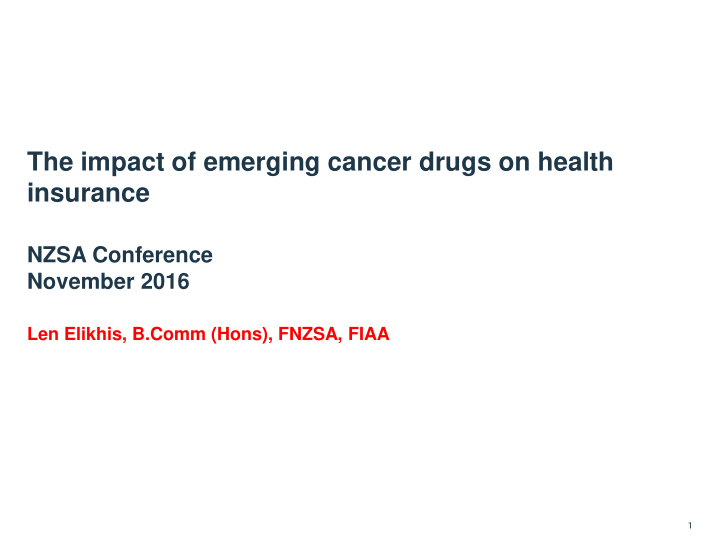



The impact of emerging cancer drugs on health insurance NZSA Conference November 2016 Len Elikhis, B.Comm (Hons), FNZSA, FIAA 1
Agenda 1. Background 2. Accounting & reserving practices 3. Developments in cancer care 4. Implications The views here are my own and do not necessarily reflect those of my employers – past or present. 2
Background 3
Role of health insurance in NZ Approval and Funding purchasing MOH ACC PHI MedSafe Some co- 20 DHBs funding Pharmac Healthcare delivery Public Mental GPs / Semi Elective Maternity Hospitals Health primary acute 4
Long-term nature of health insurance Guaranteed renewability Non-cancellable Renewal on original terms 5
Long-term nature of health insurance Pure Self Risk Funding insurance Health insurance 6
Long-term nature of health insurance Cost of renewability option High risk claimants 7
Long-term nature of health insurance Cost of renewability option 1 – 1.5% for each year of portfolio duration Selective lapsation 8
Background Accounting 9
IFRS 4: same contract – different treatment Life insurance Non-life insurance BEL Unearned premium PVFP IBNR IBNR UPR UPR 10
Health insurance reserving in NZ Reserve Statutory Management IBNR 7 7 RBNA 3 3 Catastrophe 0 1 Guarantees / options 1 2 Claims expense 6 6 UPR 7 7 11
Health insurers fund claims costs on a PAYG basis Selective Higher risk lapsation claimants No explicit allowance 4 7 Explicit allowance 3 0 12
By contrast, ACC is fully funded Eliminate the transference of financial responsibilities between generations 13
14
Differences in reserving practices: health insurers and ACC Interpretation of the Accounting Standards? Market competition? Industry capitalisation? 15
Developments in cancer care 16
Health insurance coverage: continuum of cancer care Specialist consultations 17
Health insurance coverage: continuum of cancer care Diagnostic scans 18
Health insurance coverage: continuum of cancer care Cancer drugs 19
Health insurance coverage: continuum of cancer care Radiation therapy 20
Health insurance coverage: continuum of cancer care Surgery (therapeutic and reconstructive) 21
Health insurance coverage: continuum of cancer care Other services 22
Chemotherapy: from the trenches to the theatre 23
Chemotherapy: mode of action 24
Chemotherapy: toxicity 25
Chemotherapy: toxicity 26
Immunotherapy: harnessing the immune system Monoclonal antibodies 27
Immunotherapy: harnessing the immune system Immune checkpoint inhibitors 28
Immunotherapy: harnessing the immune system Immune checkpoint inhibitors 29
Immunotherapy: harnessing the immune system Cell based therapies 30
Immunotherapy: lower toxicity 31
Implications Implications 32
Funders should expect increased spending • Longer treatment durations • Patents • Competition • Combination therapies • Policy settings 33
Consumer expectations There are many things patients are willing to do without; however, medication for a fatal disease is not and should not be one of them. The seriousness of a cancer diagnosis plays a role in how much cost patients and physicians are willing to bear for modest incremental benefits. However, high prices for incremental benefits are a recipe for a system with unsustainable costs. - Siddiqui and Rajkumar, Mayo Clinic (2012) 34
Cost trend: US perspective 35
Cost trend: NZ perspective 36
Cost trend: NZ perspective 37
Coverage levels: NZ insurers Retail health policies are pro-consumptive and generally offer wide coverage 38
Responding to emerging claims • Exclusions for experimental treatment • Medical necessity (treatment without curative intent?) • Reasonable charges • Treatment criteria • Affiliated Providers • Ability to vary contract terms • Pricing 39
Pulling the pricing lever: is it fair? The competitive cycle weakens the sustainability of retail health insurance Insurer A gains competitive Insurer A “ring - fences” price advantage Healthy customers transfer to Other insurers follow new product Remaining customers pay Cross-subsidies reduce higher premiums 40
Implications Conclusions • Health insurance is a long-term product • Evidence suggests that cancer costs may expose insurers to even longer-tail claims • Market forces constrain insurers’ ability to pre -fund liabilities – pricing becomes increasingly important 41
Recommend
More recommend